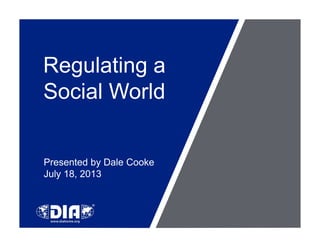DIA Webinar Regulating a Social World
- 1. Regulating a Social World Presented by Dale Cooke July 18, 2013
- 2. The views and opinions expressed in the following PowerPoint slides are those of the individual presenter and should not be attributed to Drug Information Association, Inc. (ŌĆ£DIAŌĆØ), its directors, officers, employees, volunteers, members, chapters, councils, Special Interest Area Communities or affiliates, or any organization with which the presenter is employed or affiliated. These PowerPoint slides are the intellectual property of the individual presenter and are protected under the copyright laws of the United States of America and other countries. Used by permission. All rights reserved. Drug Information Association, DIA and DIA logo are registered trademarks or trademarks of Drug Information Association Inc. All other trademarks are the property of their respective owners. Disclaimer 2www.diahome.orgDrug┬ĀInformation┬ĀAssociation
- 3. SOCIAL MEDIA IN HEALTH
- 4. Consumers either creating or consuming content on or in health blogs, message boards, chat rooms, health social networks, health communities, and patient testimonials. 109 million U.S. adults are creating or consuming health-related UGC online Source: ePharma Consumer┬« v9.0 Source:┬ĀManhattan┬ĀResearch┬ĀCybercitizen┬ĀHealth┬« v7.0ŌĆÉv12.0 Especially patients with rare diseases Much of their rare-disease patient interaction happens online by necessity, since they are unlikely to live near the people who share their conditions Source:┬ĀPew┬ĀInternet┬Ā&┬ĀAmerican┬ĀLife┬ĀProject,┬ĀPeerŌĆÉtoŌĆÉPeer┬ĀHealthcare,┬Ā February┬Ā2011
- 5. Use of social media for health peaks when patients are recently diagnosed The patient journey also plays a role in interaction with social media 18% 18% 17% 33% 2% 4% 11% 12% 37% 37% 40% 67% 15% 18% 25% 35% Health┬Āblog Health┬Āmessage┬Āboards┬Āor┬Ācommunities Patient┬Ātestimonials Health┬Āratings┬Āor┬Āreviews Twitter Google┬ĀPlus YouTube Facebook Diagnosed┬Āwith┬Āa┬Āchronic┬Ācondition┬Āin┬Āpast┬Ā3┬Āmonths Have┬Āa┬Āchronic┬Ācondition┬Ābut┬Ādiagnosed┬Āmore┬Āthan┬Ā1┬Āyear┬Āago HealthŌĆÉspecific┬Ā social┬Āmedia General┬Āsocial┬Ā networks Among online consumers Source: Manhattan Research, Cybercitizen Health┬« U.S., 2012 Online┬Āresources┬Āused┬Āfor┬Āhealth┬Ā in┬Āpast┬Ā12┬Āmonths
- 6. FDA GUIDANCE ON SOCIAL MEDIA
- 7. What we have receivedŌĆ” For more info on these guidances, see http://www.scribd.com/dale_cooke/documents
- 8. Guidance for Industry The Bible of How to Use Social Media Compliantly ŌĆ”what we wonŌĆÖt get
- 9. RELEVANT FDA ENFORCEMENT ACTIVITIES & THEIR IMPLICATIONS
- 11. Reminder Advertising Three seemingly acceptable formats Disease┬ĀAwareness┬Āto┬ĀDisease┬ĀAwareness┬ĀAdvertising Redirects┬Ā(Unbranded┬Āto┬ĀBranded┬ĀContent)
- 12. Date: July 29, 2010 Violations ŌĆó Unsubstantiated superiority claim ŌĆó DidnŌĆÖt submit 2253 ŌĆó DidnŌĆÖt include risk information Lessons ŌĆó Social media is OK if done correctly ŌĆó Subpart H does NOT restrict content or media ŌĆó Pharma is responsible for all (and only) content they make accessible Facebook sharing for Tasigna from Novartis For more info on this action, see http://www.scribd.com/dale_cooke/documents
- 13. Date: May 5, 2011 Violations ŌĆó Omission of risk information ŌĆó DidnŌĆÖt submit 2253 ŌĆó Misleading claims Lessons ŌĆó EVERYONE needs a social media policy ŌĆó Well-intentioned employees put themselves and the company at risk ŌĆó Must include risk information with the benefit claims YouTube video for Atelvia from Warner Chilcott
- 14. Key Requirements ŌĆō Product Name Usage ŌĆō Fair Balance ŌĆō Indication Statement ŌĆō Adequate Provision (Directions for Use) ŌĆō MedWatch Statement Four Types of Communication ŌĆō Reminder Ads ŌĆō Product Promotions ŌĆō Disease Awareness Communications ŌĆō Redirecting Communications Regulatory implications
- 15. ADDRESSING THE UNIQUE CHALLENGES OF SOCIAL MEDIA
- 16. ŌĆó Responsiveness ŌĆó Dealing with AEs ŌĆó 2253 Filing Requirements Unique challenges for social media
- 17. Establish a decision tree
- 18. Make use of boilerplate responses
- 19. 3 layers of moderation and filtration Software Keyword Blocklist Human Moderation Services Our 1st Line of Defense Our 2nd Line of Defense Our 3rd Line of Defense Social Platform Native Keyword Blocklist and SPAM filter
- 21. Governance & policy development Governance Determining┬Āthe┬Ārules┬Āof┬Āengagement and┬Āthe┬Āroles┬Ā and┬Āresponsibilities┬Āamong┬Āthe┬Āvarious┬Āstakeholders,┬Ā including┬Āwho┬Āowns┬Āpolicy┬Ādevelopment,┬Āenforcement,┬Āetc. Policy┬ĀDevelopment Conducting┬Āa┬Āgap┬Āanalysis on┬Āexisting┬Āpolicies,┬Ā achieving┬Āstakeholder┬Āinput,┬Āand┬Āestablishing┬Ā procedures┬Āfor┬Āpolicy┬Ārollout┬Āand┬Āupdates Employee┬ĀEfforts ŌĆó Protect┬Āthe┬Ācompany ŌĆó Protect┬Āemployees ŌĆó Foster┬Āa┬Āspirit┬Āof┬Āinnovation Company┬ĀEfforts ŌĆó Ensure a┬Āconsistent┬Āvoice ŌĆó Establish┬Āstandards┬Ā&┬Ābest┬Ā practices ŌĆó Enable┬Āspeed┬Āto┬Āmarket ŌĆó Avoid┬Āduplicative┬Āefforts ŌĆó Document┬Ā&┬Āshare┬Āsuccesses
- 22. > Conduct training sessions ŌĆó Provide examples of permissible and impermissible activities > Incorporate the policy into new employee onboarding > Designate a social media ombudsman to answer questions > Use social media for something ŌĆó Establish a Facebook page for corporate announcements ŌĆó Use an internal Twitter feed for employee news > Regularly review/update the policy Keys to successful policy rollout
- 23. > Medical-legal-regulatory review process > Adverse event reporting > Media relations activities > Call center scripts & training Leveraging and modifying existing systems
- 24. > Making a commitment to responsiveness > Acknowledging the need for speed > Setting the expectations > Recognizing the specs Streamlining the review & approval process
- 25. Questions? Dale Cooke Dale.Cooke@DigitasHealth.com @PhillyCooke on Twitter www.scribd.com/Dale_Cooke
- 26. About the presenter: Dale Cooke, VP/GD, Regulatory, Digitas Health Dale Cooke is the head of Regulatory for Digitas Health. He has worked with more than 25 pharmaceutical and medical device clients and with Medical- Legal-Regulatory committees around the world from offices in Philadelphia, New York, Boston, and London. Dale advises clients on FDA enforcement actions and provides recommendations for compliance with FDA regulations, with a focus on issues involving the Internet and emerging technology. His insights have been featured in the Wall Street JournalŌĆÖs Health blog, The Pink Sheet, MedAdNews, PharmExec, and others. Dale is a member of the Drug Information Association (DIA), Regulatory Affairs Professionals Society (RAPS), and the Food and Drug Law Institute (FDLI). Dale is the author of Effective Review and Approval of Digital Promotional Tactics, which is part of the FDLI primer series. He is regularly invited to speak at industry conferences on topics including FDA enforcement trends, best practices for review processes, global review practices, and pharmaceutical involvement in social media. Dale earned his B.A. in Philosophy from Southern Methodist University and an M.A. in Analytical Philosophy from the University of Arizona and studied Epidemiology and Biostatistics at Drexel UniversityŌĆÖs School of Public Health.


























